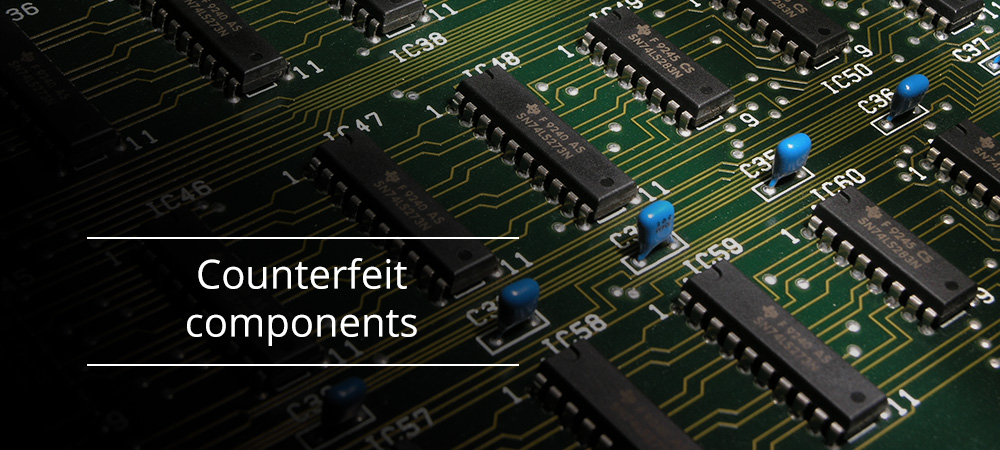
According to an article published by the french newspaper Le Monde in 2016, counterfeit electronic components cause from 7 to 10% losses for the industry out of a total turnover of 309 billion euros in 2015, in other words, the equivalent of 21 to 30 billion euros. From destroying a computer to compromising the integrity of complex systems costing several million euros, illegal copies are a major risk for the sector.
In order to combat this increasingly widespread phenomenon, researchers and manufacturers have to be more inventive than the counterfeiters to block them and find new strategies to protect themselves.
The illegal copy market is booming
At least one in every two semiconductor manufacturers has had to face the counterfeiting of its technology and it is thought that the number of copies circulating has quadrupled since 2009. Aviation industrials have found counterfeit electronics in their supply chain, which appeared to be genuine but which in fact were empty. In 2010, the American military were the first to denounce this wave of illegal components. Defective components have disrupted helicopter infrared vision systems, patrol aircraft de-icing or the flight display on transport aircraft.
In 2016, a computer-killing thumb drive created a buzz. It contains a DC-DC converter and capacitors that send a charge that destroys PC components when connected. The killer thumb drive repeats the operation until its purpose has been achieved. A Hong-Kong based company has copied the thumb drive and offers it for sale. Officially it is intended for consultants specialised in computer security.
Defective electronic components are an issue for several very obvious reasons:
- A risk of injury or even death in some sectors (medical, military, automotive)
- Risk of fires due to short circuits
- Altered product performances
- High costs and lost revenue for the industry
Counterfeiters use several methods to copy components. They can attempt to obtain electronic component blueprints using various espionage techniques or retro-engineer them to try and discover their secrets.
Why counterfeits are flooding the market
The media often talks about counterfeit luxury goods, but all sectors are impacted to a varying degree and differing safety risks depending on the products. Contrary to the luxury goods sector, there is no room for error in the military, aviation, automotive or medical industries.
There are several reasons for the boom in copied components:
- Globalisation has considerably reduced the cost of access to technology
- The outsourcing of production to Asia has made technology transfers easier
- The interoperability of IT operating systems has enabled mass data dissemination
- The major goods carriers have adapted their offers to make the shipping of small packages affordable
- Counterfeits are also the result of the production of electronic waste which developed countries send to developing countries. Counterfeiters use this waste as raw material to produce illegal copies of components.
Techniques used by illegal manufacturers: non-functional units, sandblasting and remarking, blacktopping, device substitution, use of rejects, falsified labelling, etc.
and get your PCBA quote within the next 10 minutes!
The fight against counterfeits: component checking
Check the components
The first thing to do is to carry out a series of checks on electronic components to make sure they are undamaged (AOI, electric, impedance tests, micro-sectioning or X-Ray inspections).
An X-Ray machine can provide a detailed and non-intrusive inspection of dies, solders and detect delamination. Then all is needed is to compare with the manufacturer’s specifications to check that the component is genuine. In the same vein, an electric test on suspicious components will give a tolerance that can be compared with manufacturer data. If the difference is too significant, further investigation is required.
By measuring the height, length and width and comparing them with manufacturer’s specifications, we can also deduce whether the component is counterfeit or not.
Identify blacktopping
Widely used by counterfeiters, Blacktopping consists in hiding the original serial number and printing a different marking over it to deceive the purchaser. This can’t be detected by the naked eye, but an experienced eye can detect the fraud under a microscope. Acetone can also be used to remove the fake marking.
Decapsulation
As a last resort, the dismantling of the component implies an intrusive, and therefore destructive, operation. However, this is really the last solution to see what’s inside a component if none of the other tests were able to prove its authenticity. A powerful microscope is used to inspect the manufacturer's marking, the defective parts, the font and the authenticity of serial numbers.
Fighting against counterfeiting upstream
Fighting against counterfeiting upstream
Purchasing directly from the manufacturer seems to be a reliable way of reducing the risk to a minimum. Multiplying the number of intermediaries reduces transparency and increases risk.
Know your suppliers
Le GIDEP or Government – Industry Exchange Program is a database that lists the components suspected by North American industry to be counterfeits.
Other items need to be checked to make sure your supplier is honest:
- Does your supplier reveal the list of its suppliers to provide maximum transparency?
- Do they comply with the international AS6081 standard on fraud and counterfeit electronic components?
- Does your supplier make sure the minimum tests required by the AS553A standard are carried out?



